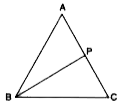ABC is an equilateral triangle where AB = a and P is any point in its plane such that PA = PB + PC. Then is
3
2
The correct Answer is:D
To solve the problem, we will follow a step-by-step approach to derive the required expression.
Step 1: Understand the given information
We have an equilateral triangle ABC with sides AB = a. A point P exists such that PA = PB + PC. We need to find the value of the expression PA2+PB2+PC2a2.
Step 2: Use the properties of the equilateral triangle
In an equilateral triangle, all angles are equal to 60 degrees. Therefore, if we consider the circumcircle of triangle ABC, point P lies on the arc BC. This means that the angle subtended at point P by points B and C is 120 degrees (since the angle subtended at the center is double that at the circumference).
Step 3: Apply the Cosine Rule in triangle BPC
Using the cosine rule in triangle BPC:
PB2+PC2−2⋅PB⋅PC⋅cos(120∘)=BC2
Since cos(120∘)=−12 and BC=a, we can rewrite this as:
PB2+PC2+PB⋅PC=a2
Step 4: Rearranging the equation
Rearranging the equation gives us:
PB2+PC2=a2−PB⋅PC
Step 5: Substitute PA = PB + PC
We know from the problem statement that PA=PB+PC. Squaring both sides gives:
PA2=(PB+PC)2=PB2+PC2+2PB⋅PC
Step 6: Substitute the expression for PB² + PC²
Now substituting the expression for PB2+PC2 from Step 4 into the equation from Step 5:
PA2=(a2−PB⋅PC)+2PB⋅PC
PA2=a2+PB⋅PC
Step 7: Find PA2+PB2+PC2
Now we can find PA2+PB2+PC2:
PA2+PB2+PC2=(a2+PB⋅PC)+(a2−PB⋅PC)=2a2
Step 8: Calculate the final expression
Now, we substitute this into our required expression:
PA2+PB2+PC2a2=2a2a2=2
Final Answer
Thus, the value of PA2+PB2+PC2a2 is 2.
We have an equilateral triangle ABC with sides AB = a. A point P exists such that PA = PB + PC. We need to find the value of the expression PA2+PB2+PC2a2.
In an equilateral triangle, all angles are equal to 60 degrees. Therefore, if we consider the circumcircle of triangle ABC, point P lies on the arc BC. This means that the angle subtended at point P by points B and C is 120 degrees (since the angle subtended at the center is double that at the circumference).
Using the cosine rule in triangle BPC:
PB2+PC2−2⋅PB⋅PC⋅cos(120∘)=BC2
Since cos(120∘)=−12 and BC=a, we can rewrite this as:
PB2+PC2+PB⋅PC=a2
Rearranging the equation gives us:
PB2+PC2=a2−PB⋅PC
We know from the problem statement that PA=PB+PC. Squaring both sides gives:
PA2=(PB+PC)2=PB2+PC2+2PB⋅PC
Now substituting the expression for PB2+PC2 from Step 4 into the equation from Step 5:
PA2=(a2−PB⋅PC)+2PB⋅PC
PA2=a2+PB⋅PC
Now we can find PA2+PB2+PC2:
PA2+PB2+PC2=(a2+PB⋅PC)+(a2−PB⋅PC)=2a2
Now, we substitute this into our required expression:
PA2+PB2+PC2a2=2a2a2=2
Thus, the value of PA2+PB2+PC2a2 is 2.
Topper's Solved these Questions
- SOLUTIONS AND PROPERTIES OF TRIANGLE Book:CENGAGE ENGLISHChapter:SOLUTIONS AND PROPERTIES OF TRIANGLE Exercise:Multiple Correct Answers Type
Explore 13 Videos
- SOLUTIONS AND PROPERTIES OF TRIANGLE Book:CENGAGE ENGLISHChapter:SOLUTIONS AND PROPERTIES OF TRIANGLE Exercise:Comprehension Type
Explore 6 Videos
- SET THEORY AND REAL NUMBER SYSTEM Book:CENGAGE ENGLISHChapter:SET THEORY AND REAL NUMBER SYSTEM Exercise:Archives
Explore 1 Video
- STATISTICSBook:CENGAGE ENGLISHChapter:STATISTICSExercise:Archives
Explore 10 Videos
Similar Questions
ABC is an equilateral triangle, P is a point in BC such that BP : PC =2 : 1.
Prove that : 9AP2=7AB2
View SolutionIn the following figure, ABC is an equilateral triangle and P is any point in AC, prove that :
(i) BP>PA
(ii) BP>PC

View SolutionIn the following figure, ABC is an equilateral triangle and P is any point in AC, prove that :
(i) BP>PA
(ii) BP>PC

View SolutionIf P be any point in the plane of square ABCD, prove that
PA2+PC2=PB2+PD2
View Solutionlf G be the centroid of a triangle ABC and P be any other point in the plane prove that PA2+PB2+PC2=GA2+GB2+GC2+3GP2
View SolutionABCD is a parallelogram of area 162 sq. Cm P is a point on AB such that AP : PB = 1 :2
Calculate
The ratio of PA : DC.
View SolutionP is any point in the interior of a triangle ABC.
Prove that : PA+PB<AC+BC
View SolutionP is any point in the interior of a triangle ABC.
Prove that : PA+PB<AC+BC
View SolutionIf A and B are two fixed points and P is a variable point such that PA+PB=4, the locus of P is
View SolutionP is a point inside the rectangle ABCD such that PA=2, PB=9, PC=10 & PD=√k then k is equal
View Solution
